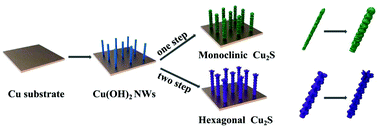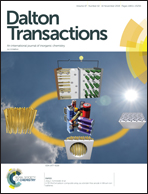Hierarchical Cu2S nanorods with different crystal phases for asymmetrical supercapacitors and visible-light photocatalysis†
Abstract
Nanomaterials with hierarchical structures have attracted much attention recently due to their impressive behavior in many fields. Herein, hierarchical Cu2S nanorods with monoclinic and hexagonal phases are first in situ grown on copper sheets by simple hydrothermal methods. The solvent largely influences the feature of Cu2S nanorods during the growth process and the proposed mechanism is elaborately elucidated for these different Cu2S nanorods. Owing to their wheat-like architecture and higher electrical conductivity, the hexagonal Cu2S nanorods exhibit superior electrochemical performance with a specific capacitance of 346 mF cm−2 at 5 mA cm−2 and more than 90% capacitance after 2000 cycles. The solid-state asymmetrical supercapacitors based on the hexagonal Cu2S electrodes have a specific capacitance of 172 mF cm−2 at 5 mA cm−2 and excellent electrochemical stability with ∼90% capacitance after 2000 cycling tests. Moreover, the hierarchical Cu2S nanorods show great photocatalytic ability in the degradation of methylene blue (MB) and rhodamine B (RhB) dyes with the assistance of H2O2 under visible light. This work provides a way to fabricate copper sulfides with hierarchical structures and multi-functions.



 Please wait while we load your content...
Please wait while we load your content...